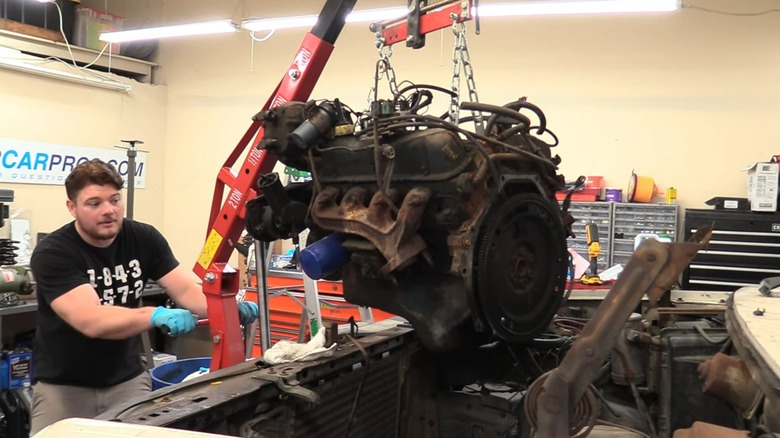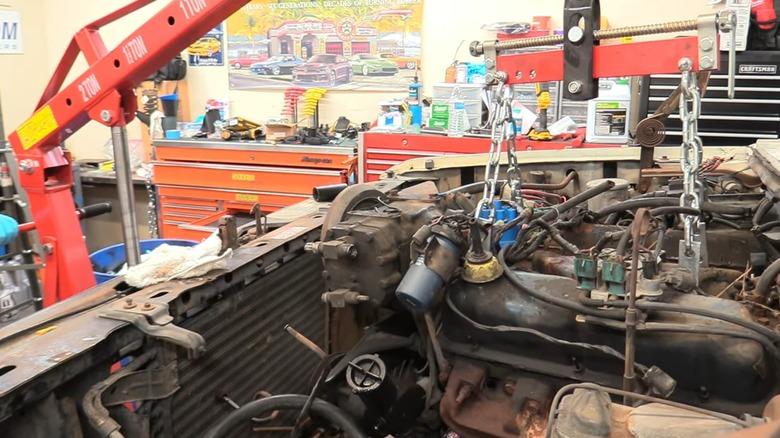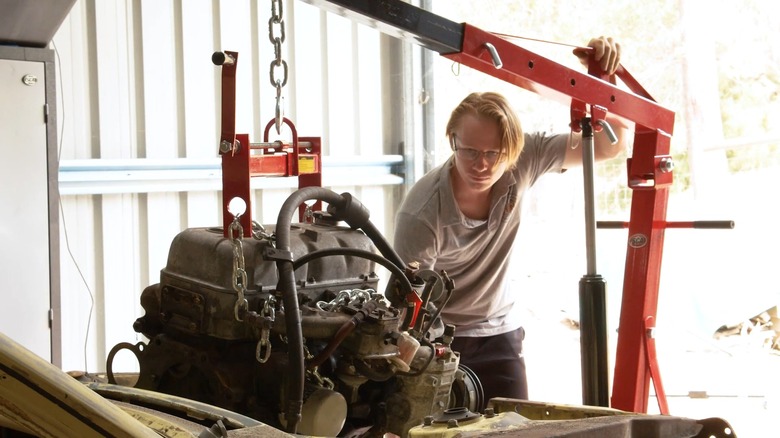Don't Have An Engine Hoist Of Your Own? You Can Rent One Before Your Next Project
Engine hoists — frequently referred to as cherry pickers — are supremely useful tools for motor swaps, rebuilds, and various other jobs. They allow us to connect a crane to a car's engine and, using a hydraulic jack, enable us to lift the motor out of the vehicle. This is important because car engines are extremely heavy and cumbersome. A normal person won't be able to remove one from their car alone, and even with a few people, removing a motor by hand will be incredibly challenging.
However, engine hoists can also be quite costly and difficult to store due to their large size. For home mechanics and DIYers with limited garage space, finding a place to stash an engine hoist after the job is complete may be impossible. For those on a budget, dropping several hundred bucks on a tool they may only use once or twice probably isn't the most practical decision. Instead, DIYers and home mechanics around the country have some other options when it comes to these niche devices. Many stores and businesses rent tools — including engine hoists — for reasonable rates.
Some of the most well-known sources of tool rentals include auto parts stores like AutoZone, a popular supplier of underrated tools. While you may not be able to find cherry picker rentals at all auto parts stores, they're worth visiting to find out. Outside of major auto parts stores, there are several national chains that provide tool rentals and various smaller local mom-and-pop businesses that may also be worth checking out. All that said, let's go ahead and dive in to explore some of the best places to rent engine hoists and how to use one once you secure your rental.
Engine hoist rentals are available at various national chains
There are plenty of options when it comes to engine hoist rentals from various national chains supply tool rentals across Canada, the United States, and Mexico. If you're looking for a cherry picker, and you only need one for a day or two, these places could be solid options and are definitely worth checking out before you buy your own or start quoting prices with local shops.
Places like Sunbelt Rentals and United Rentals maintain locations across most of North America. They allow you to input your location, the length of time you'll need the hoist, and whether you plan to pick it up yourself or want the company to deliver it. Your rate is based on that information. Sunbelt Rentals provides relatively transparent pricing and gives you the option to rent tools by four-hour blocks, one day, or one week. United Rentals, on the other hand, does not appear to offer engine hoist rentals at all of its locations — we input several major cities during our research and were surprised to learn that hoists were not available at most of them. That said, you may be able to contact the company for more detailed information and alternative options for your rental. Overall, both companies have average customer reviews and relatively competitive rates.
Outside of national rental companies like those covered above, don't forget to reach out to auto parts stores in your area. While not every store will offer engine hoist rentals, many do, and you may be able to get a better rate through these suppliers. In fact, several auto parts stores, like AutoZone, have a loan-a-tool program, allowing you to put down a small refundable deposit and use the tool for up to 90 days.
You may be able to find engine hoist rentals locally, too
In addition to national rental companies and auto parts store chains, you may also be able to find an engine hoist rental from a local business. There are various mom-and-pop stores located across the U.S. and greater North America. Many of these businesses offer great rates on rental equipment, ranging from trucks to auto repair tools and even things like tractors and lawn mowers. However, because locally-owned businesses differ from state to state, you'll have to do your own research to find the right place.
That said, the good thing about renting from a local business is that small shops and rental companies may provide substantially better customer service than large faceless corporations. Furthermore, by using a locally-owned business, there's a greater chance that the money you spend will remain in your community. The downside to renting from a smaller business is that rates tend to be higher. Locally-owned shops and rental companies typically can't compete with the prices set by massive corporations. The trade-off, as mentioned, is that the customer service provided by small businesses is usually superior. It's up to you to decide whether it's worth paying a higher rate for better service, or if you're content with the service and prices offered by large, national companies.
How do you use an engine hoist?
If you're searching for a place to rent engine hoists, it's probably because you're planning a motor swap or some other form of engine repair/modification. But locating a cherry picker rental is only one part of the process. You need to have the right know-how to operate the engine hoist safely. Fortunately, engine hoists aren't that complicated, and with the right guidance, even novices can use one easily.
The first step is to disconnect the engine from all the components that are easier to remove separately or that will remain in the engine bay. That means hoses, wiring harnesses, and transmission connections. That does not mean you should disconnect the engine mounts — motor mount bolts will be the last thing you disconnect before removing the engine. Next, you'll need to position the hoist according to its weight capacity and attach its chains to your motor. Some engines have built-in lift points, while others require you to bolt on a lifting plate or connect the chain to the block. It's important that you research and understand your engine prior to removing it — doing so will help you complete the project with minimal hassle, injuries, and mechanical damage.
Finally, when your engine is secured to the hoist, use the hydraulic jack to remove the slack and lift the motor off its mounts. When you remove the tension from the mounts, you can disconnect the remaining bolts and slowly and carefully remove the engine from the vehicle. Ideally, you'll then move your motor to an engine stand where you can work on it safely. However, if you don't have an engine stand, you can gently place it on a wooden pallet or another type of non-marring support.



